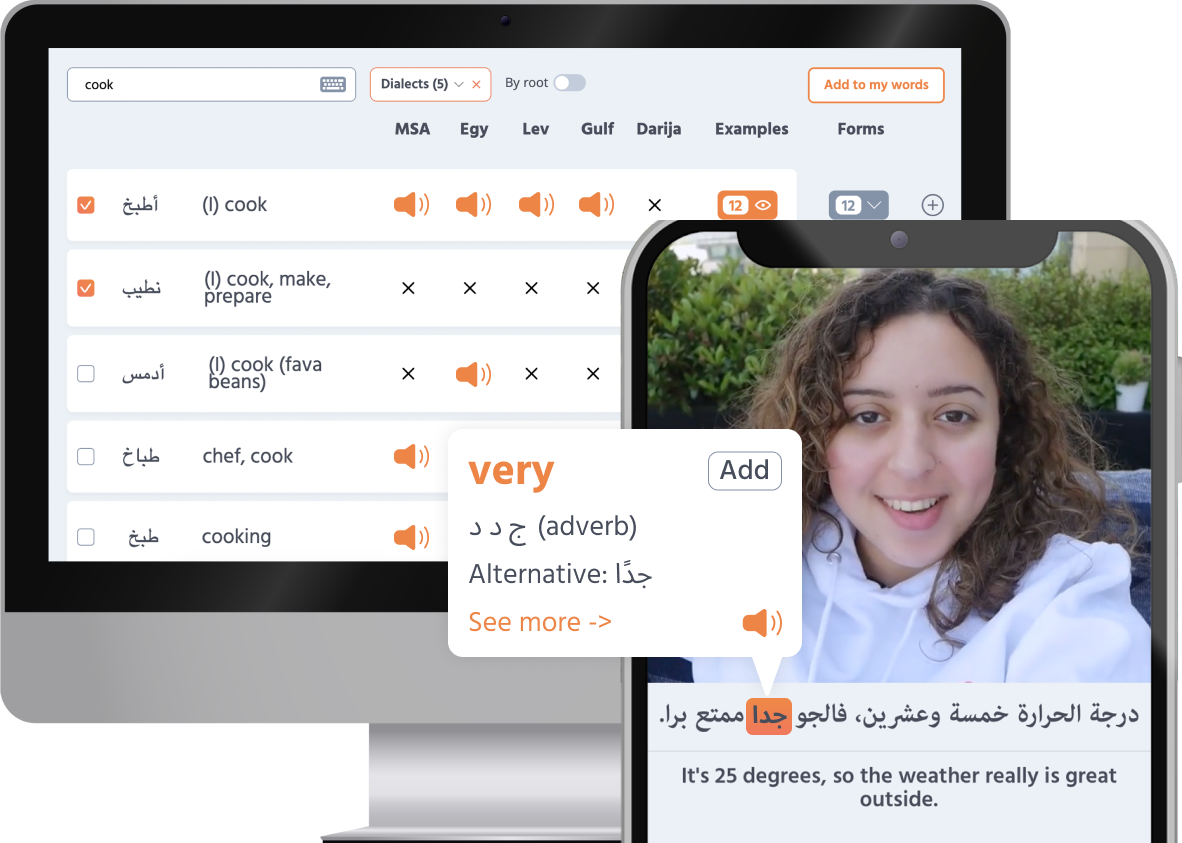Discover the Beauty of Arabic Dialects
Learn spoken Arabic today with real-world videos, interactive captioning, and fun exercises.
Welcome to Playaling, your gateway to the vibrant world of Arabic dialects. Our platform is not just about learning a language; it’s an exploration of the diverse cultures and linguistic flavors that make up the rich tapestry of the Arabic-speaking world.
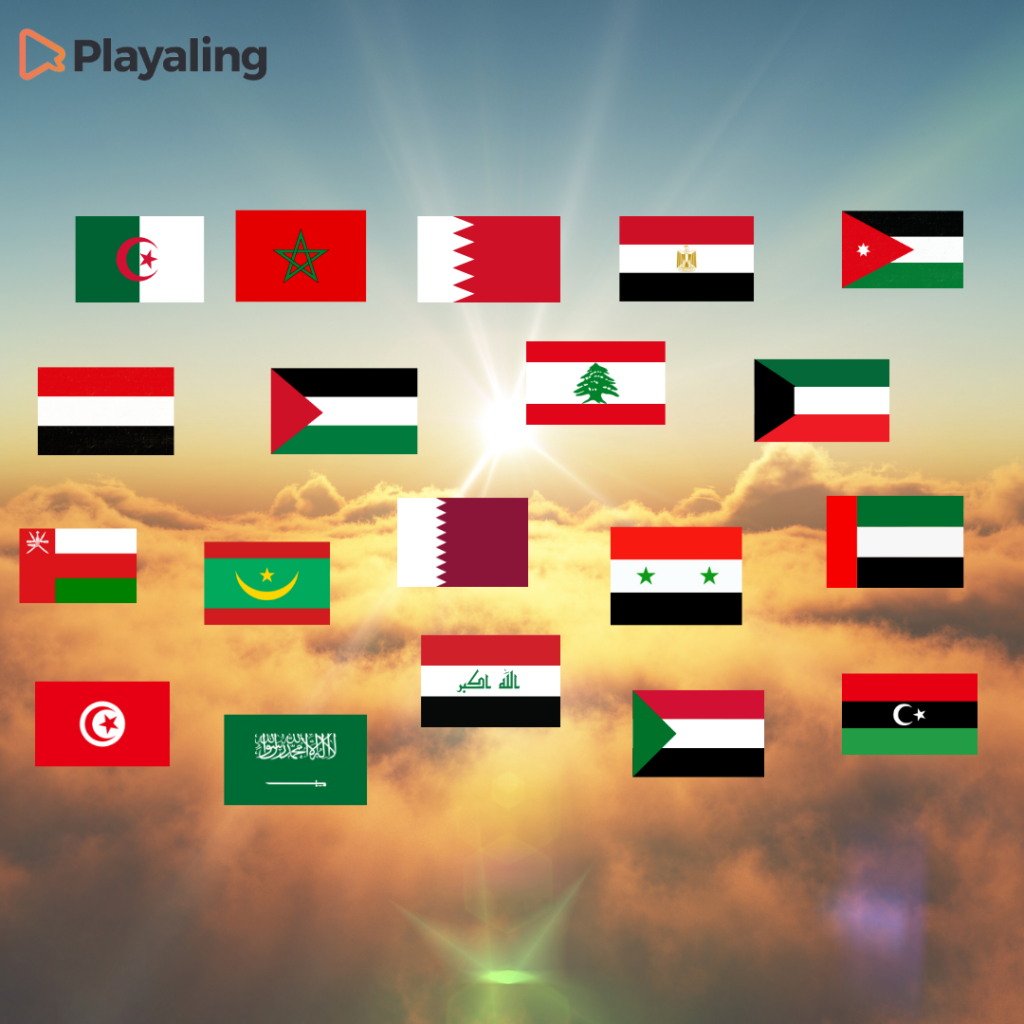
More than 550 million people around the world speak Arabic, with approximately 300 million considering it their native language and around 250 million using it as a second language. This positions Arabic as the fourth most spoken language globally, following Chinese, English, and Spanish.
The standard version of the language, what is known as Modern Standard Arabic (MSA), is not used natively by any population; instead, it is acquired through formal education. This situation elevates the significance of Arabic dialects, as they are the primary means of everyday communication among native speakers. These dialects, rich in cultural nuance and regional variation, are indispensable for genuine interaction with Arabic-speaking communities. To truly connect with the essence of Arab culture and everyday life, gaining proficiency in at least one dialect is essential, extending beyond academic or formal settings.
Arabic dialects – all you should know
Due to complex historical, geographic, sociopolitical, and cultural factors – including the spread of Islam and the Arab Empire, interactions with other languages and cultures, diverse ethnic groups, linguistic influences, lack of standardization in spoken Arabic, and strong oral traditions – distinct dialects exist across Arabic-speaking regions, contributing to the richness and complexity of the language.
The main dialects can be broadly categorized as follows:
- Levantine: This is the Arabic dialect spoken in Syria, Lebanon, Jordan, and Palestine. It is widely understood by most Arabs, thanks to Syrian TV series like Bab Alhara, and the dubbing of popular Turkish TV shows in Syrian dialect.
- Egyptian: The predominant dialect in Egypt, by far the most populated country in the Arab world. Egyptian media, particularly Egyptian movies, television series, and music, have had a significant impact across the Arab world for decades. This exposure to Egyptian dialect through entertainment has familiarized Arabs with its sounds, phrases, and nuances.
- Gulf: Encompassing the Arab dialects in the Gulf region, including Saudi Arabia, the United Arab Emirates, Kuwait, Bahrain, Qatar, Oman, and southern Iraq.
- Darija: Also known as Maghrebi Arabic, it is the native dialect for most people living in the Maghreb (Morocco, Algeria, Tunisia, and Libya) and serves as a secondary language for Amazigh and Hassaniya minority populations.
- Iraqi: Iraqi Arabic, also known as Mesopotamian Arabic, encompasses a group of Arabic varieties mainly spoken in central and northern Iraq as well as in eastern Syria. Influences stem from interactions with neighboring languages such as Persian, Turkish, Kurdish, and ancient Mesopotamian civilizations.
Given considerable similarities among Arabic dialects and increasing exposure to diverse varieties of spoken Arabic thanks to social media, Arabs from different parts of the Middle East can often understand each other. The one notable exception is the ability of non-Maghreb based Arabs to understand Maghrebi Arabic, though most Maghrebi Arabs have no difficulty understanding other major dialects.
As a way of bridging the divides between different dialects and facilitating easier communication, it can be useful to gain exposure to Educated Spoken Arabic (ESA), a form of Arabic used among educated speakers. ESA enables effective communication in diverse settings, whether at work, in social gatherings, or during casual interactions. While Modern Standard Arabic (MSA) is used in official contexts, and often when reading from a script, ESA offers a more flexible and adaptable form of communication. Since MSA is so difficult, the vast majority of Arabs – even educated ones – are unable to speak it spontaneously without significant mistakes, which could then detract from the content of what they’re actually trying to say (For a humorous example, check: https://playaling.com/home/videos/preview/606). ESA therefores provides a flexible and more easily achievable middle ground when speaking on the fly.
At Playaling, you’ll find a dedicated section for learning Educated Spoken Arabic, in addition to Modern Standard Arabic and major dialects.
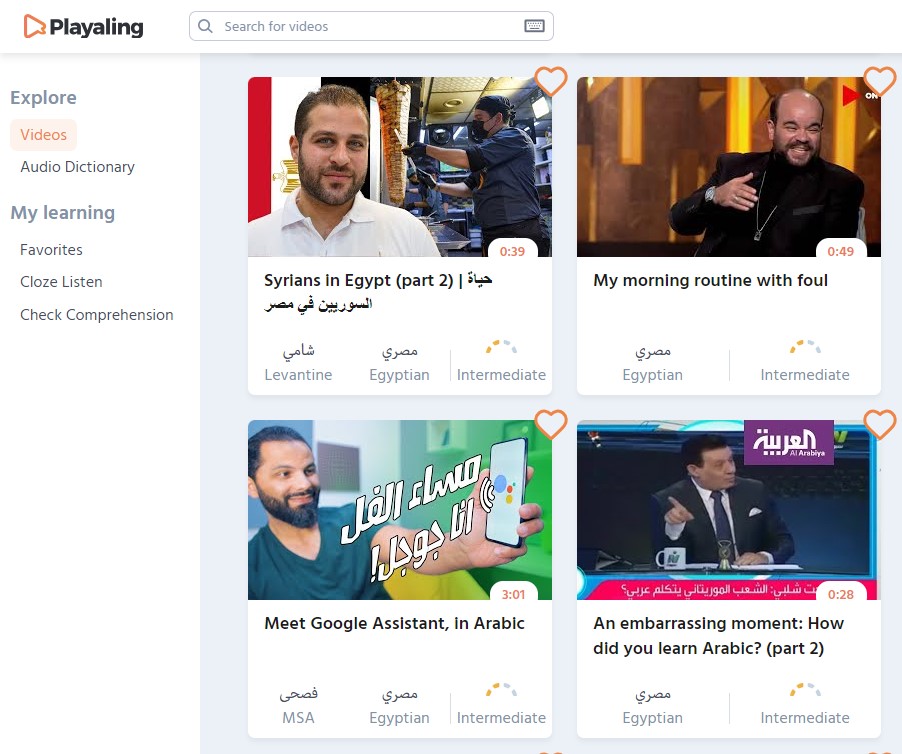
This linguistic diversity is a fascinating aspect of the Arabic language. At Playaling, we’re dedicated to helping you explore and learn Arabic and its diverse dialects through real world videos. Join us on this linguistic journey and dive into the richness of the Arabic language and its varied expressions.
How to learn different Arabic dialects
Subscribe to dialect learning apps and platforms
Stay connected with the dialect by using language learning apps and platforms. This allows you to learn during commutes, before bedtime, or any convenient time, facilitating continuous language progress. Playaling is the best option to learn various dialects at all times through diverse and suitable resources for every level and schedule.
Join online communities
Engage in online communities on platforms like Facebook or Twitter, or participate in forums dedicated to the specific dialect. Pose questions, benefit from discussions, and connect with individuals fluent in the dialect.
Interact with Arabic speakers
Communicate with speakers of the targeted dialect. Speaking with people from the Arab world opens up vast opportunities for language development, vocabulary enhancement, improved pronunciation, and the chance to make new friends.
Enroll in online courses
Explore online courses tailored to the varieties of Arabic you wish to learn. These courses often provide a structured approach, utilizing listening, watching, and reading exercises. Platforms like Playaling offer an excellent choice for learning Arabic dialects online.
Enjoy the culture of each dialect
Immerse yourself in the culture associated with each dialect. Explore literature, watch movies, and listen to music specific to the dialect. This enhances your understanding of the dialect and introduces you to the unique culture of that region.
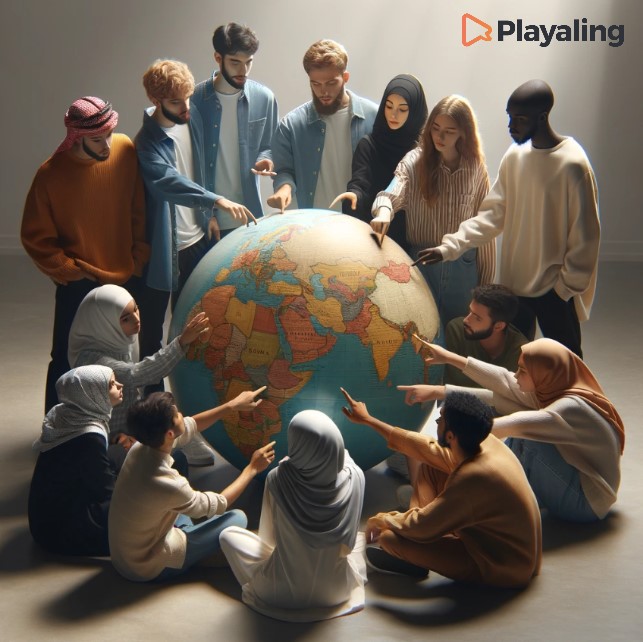
Why learn Arabic with Playaling?
Playaling offers abundant educational resources for both Modern Standard Arabic and the four main Arabic dialects. Here, you can search for any word to understand its meaning and pronunciation in both Modern Standard Arabic and your dialect(s) of choice. This is useful when learning different dialects, as being able to compare them with each other and Modern Standard Arabic can significantly increase the quality and accelerate the speed of language comprehension and learning.
At Playaling, you can learn and immerse yourself in the culture of each Arab country, discovering how people speak in their homes, on the streets, among family members, and with friends. It’s like visiting them, sitting with them, and listening to their daily conversations, all while sitting at your computer or with your mobile device. This is achieved through:
Real world videos
Authentic conversations by speakers of the targeted language or dialect, providing a genuine and informal representation of daily life.
Interactive audio dictionary
A dictionary for both Modern Standard Arabic and Arabic dialects. It includes definitions, human audio pronunciations (not robots), contextual video examples, and rich grammatical information, enhancing your understanding of practical usage. You can see all these details in the video below.
Popup dictionary
A popup dictionary where you can click on any word, hear its pronunciation by a native speaker of the dialect (not a robot), and find examples of usage, definitions, and meanings.
You can see this in the video below from an Arabic singing audition show, where a panelist speaks in the Lebanese dialect and the contestant responds in the Egyptian dialect.
Exercises and games
Various exercises, activities, and games – including fill-in-the-blanks and multiple-choice questions – designed to improve your understanding.
Playaling not only facilitates language learning but also offers a rich cultural experience, making the process enjoyable and effective.
Below is a fill-in-the-blank exercise from the video “Singing Basic Phrases of Introduction: مرحباً، أهلاً” in Modern Standard Arabic.
Common differences in pronunciation among Arabic dialects
Arabic’s rich tapestry of dialects showcases unique pronunciation variations influenced by cultural, historical, and social factors. These differences define each dialect’s distinct identity and highlight the diversity within the Arabic-speaking world. Understanding these variations is crucial for effective cross-regional communication. This discussion will explore how key letters are pronounced differently across Arabic dialects, illustrating their significant phonetic diversity.
The pronunciation of the letter ق
On a phonetic level, there are distinct differences among Arabic regions in the pronunciation of certain letters, serving as a criterion for identifying the geographical area where a specific dialect is used. The pronunciation of the letter ق is one such example:
- To understand how the letter ق is pronounced in dialects, it’s first important to understand how it’s pronounced in classical Arabic. It's similar to the "q" sound in the word "quick," but it's pronounced further back in the throat, and doesn't have a direct equivalent in English. To pronounce it, try to make a "k" sound, but instead of using the back of your tongue against the soft part of your palate (as in English), move it further back towards your throat. It might take some practice to get it right.
- In Egyptian and Levantine, however, it’s usually pronounced as a glottal stop, a type of consonantal sound produced by briefly closing the vocal cords or the glottis. It’s a very brief and abrupt interruption of airflow in the vocal tract. You can feel it if you pronounce the English word “uh-oh” — the pause between the “uh” and the “oh” is a glottal stop.
- In certain regions of Syria, parts of Algeria, and Palestinian rural areas, it is pronounced like the sound “k” without using the voice, where the back of the tongue momentarily touches the soft part of the roof of the mouth, creating a brief interruption in airflow.
- In some rural areas in the Levant and Upper Egypt (southern Egypt), and in countries of the Gulf region like Saudi Arabia, Kuwait, Qatar, Bahrain, and the United Arab Emirates, Qaf is pronounced like the sound “g” as in “go”. So, instead of just a sudden pause in airflow like in some dialects, it’s more like briefly making a “g” sound.
- In Darija, or dialects of the Maghreb (Morocco, Algeria, and Tunisia) and in Levantine, (Syria, Lebanon, Jordan, and Palestine), qāf gets pronounced the same way as in classical Arabic or MSA.
| English | Standard | Egyptian | Levantine | Gulf | Maghrebi |
|---|---|---|---|---|---|
| heart | قلب | قلب | قلب | قلب | قلب |
| stays, remains | يبقى | يبقى | يبقى | يبقى | يبقى |
| cow | بقرة | بقرة | بقرة | بقرة | بقرة |
| (he) stole | سرق | سرق | سرق | سرق | سرق |
| (we) agreed | اتفقنا | اتفقنا | اتفقنا | اتفقنا | اتفقنا |
| (he) divorced | طلق | طلق | طلق | طلق | طلق |
| coffee | قهوة | قهوة | قهوة | قهوة | قهوة |
Note: While most dialects pronounce Qaf using either the glottal stop, “k”, or “g”, some words always retain their classical pronunciation in all dialects, such as qāf in the word قُرْآن (Quran), the holy book for Muslims, or in the word القاهرة, the Arabic word for Cairo, the capital of Egypt.
The pronunciation of the letter ك
Pronounced “k” as in “kangaroo” in most Arabic dialects, it is pronounced “ch” as in “chick” in rural areas throughout the Arab world and in Iraqi and Kuwaiti dialects. For example, أحبك, usually pronounced “aHibbik,” meaning “I love you,” may become “aHibbich.” In Gulf Arabic (outside Kuwait), the letter ك may become ch
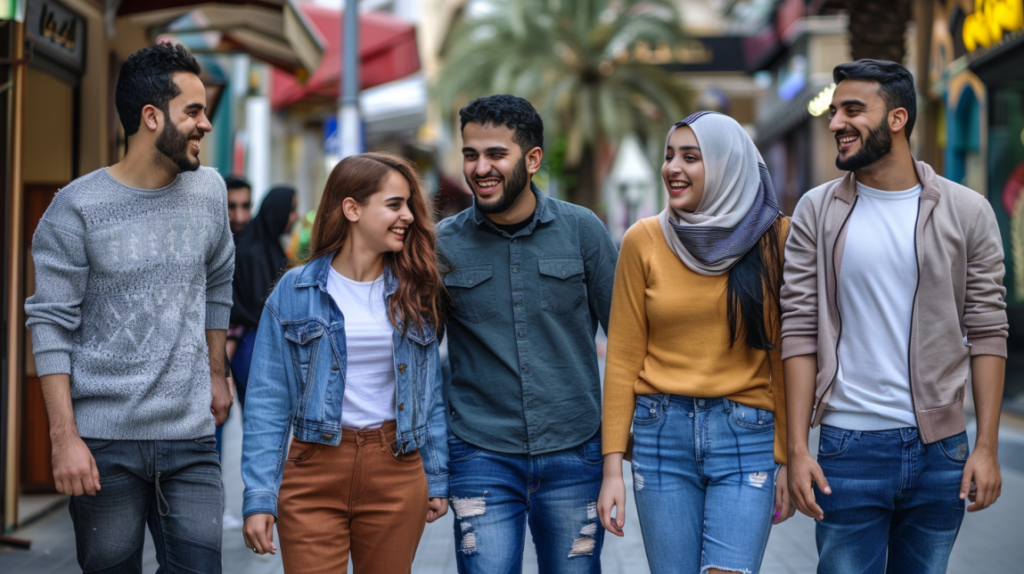
The pronunciation of the letter ج
In most dialects and in classical Arabic, this sound is usually pronounced like the “j” in “judge”. In Egyptian Arabic, this sound is pronounced like the “g” in “go.” Since this is a unique feature of Egyptian Arabic, if you hear Jeem pronounced like this, then you know you’re dealing with an Egyptian. However, Egyptians in southern Egypt and the Sinai pronounce ج the normal way.
Can you hear the difference between Egyptian Arabic and other varieties of Arabic in the chart below?
| English | Standard | Egyptian | Levantine | Gulf | Maghrebi |
|---|---|---|---|---|---|
| direction | جهة | جهة | جهة | جهة | جهة |
| university | جامعة | جامعة | جامعة | جامعة | جامعة |
| new | جديد | جديد | جديد | جديد | جديد |
| existing, available | موجود | موجود | موجود | موجود | موجود |
| beautiful | جميل | جميل | جميل | جميل | جميل |
| dialect | لهجة | لهجة | لهجة | لهجة | لهجة |
| sentence | جملة | جملة | جملة | جملة | جملة |
Common phrases in different varieties of Arabic
To illustrate the diverse pronunciations and expressions found in various Arabic dialects, we can compare common phrases as they are spoken across different regions. The following table provides examples of how phrases such as “how are you?” and “I love you” are expressed in Standard Arabic, Levantine Arabic, Gulf Arabic, Egyptian Arabic, and Darija (Maghrebi Arabic). Note that in the phrases used to address a singular male, we’ve placed (m) next to them, while for those addressing a singular female, we’ve placed (f) beside them. If no mark is provided, the phrase can be used for both males and females.
| English | Standard | Levantine | Gulf | Egyptian | Darija |
|---|---|---|---|---|---|
| how are you? | كَيْفَ حَالُك؟ (m) كيف حالكِ؟ (f) | شلونك (m) شلونِك (f) كِيْفَكْ (m) كيفِك (f) | شلونك (m) شلونك (f) | إِزَّيَكْ؟ (m) إزيِّك (f) | كِيْ دَايِر؟ (m) كي دايرة؟ (f) |
| where are you from? | مِنْ أيْنَ أنت؟ (m) من أين أنتِ؟ (f) | مْنْ وِينْ انْتَ؟ (m) من وين انتِ؟ (f) | إنْتَ مِن وين؟ (m) إنتي من وين؟ (f) | إنت منين؟ (m) إنتي منين؟ (f) | منِّينْ نْتَا؟ (m) منين نتي؟ (f) |
| what is your name? | ما اسمك؟ (m) ما اسمكِ؟ (f) | شَو اسْمَك؟ (m) شو اسمِك؟ (f) إيش اسمك؟ (m) إيش اسمِك؟ (f) | شْنُو اسْمَك؟ (m) شنو اسمِك؟ (f) | اِسْمَك إيه؟ (m) اسمِك إيه؟ (f) | آش سميتك |
| what time is it? | كَمْ السَّاعَة؟ | قدِّيْشْ السَّاعَة؟ | كَمْ السَّاعَة؟ | السَّاعَة كَامْ؟ | اشْحَالْ السَّاعَة؟ |
| I love you | أُحِبُّكَ (m) أحبّكِ (f) | بْحْبَّك (m) بحبِّك (f) | أَحِبَّك (m) أحبِّك (f) | بَحِبَّك (m) بحبِّك (f) | نْبْغِيْكْ |
These variations showcase the rich phonetic diversity across Arabic dialects, highlighting how specific letters are pronounced differently in different regions.
The linguistic diversity that distinguishes the Arab region is an integral part of a vast cultural heritage spanning from the Gulf to the Maghreb. Despite significant differences between dialects, they remain carriers of the characteristics of their speakers, expressing their local identities. The large dialectal diversity does not negate the presence of other languages in the region, such as Kurdish in northern Iraq and Syria, and Amazigh in Maghrebi countries, both playing crucial roles in cultural heritage and identity expression.
Unlock the world of Arabic dialects!
Join Playaling to learn Arabic and its diverse dialects through real world videos. With a free one-week trial, you have the opportunity to immerse yourself in the richness of the Arabic language without any financial commitment. If you decide to cancel before the trial period ends, there is no obligation to pay – it’s risk-free!
Playaling offers a plethora of unique and engaging methods to learn Arabic and its various dialects. From interactive lessons to immersive cultural experiences, we guarantee an enjoyable and effective learning process. Don’t worry about boredom; our innovative approach through real world videos keeps the learning experience fresh and dynamic.
Seize the chance to discover the beauty of Arabic language and culture. Subscribe now, and let the journey of language mastery begin. Your one-week free trial awaits – embrace the world of Arabic with us!

